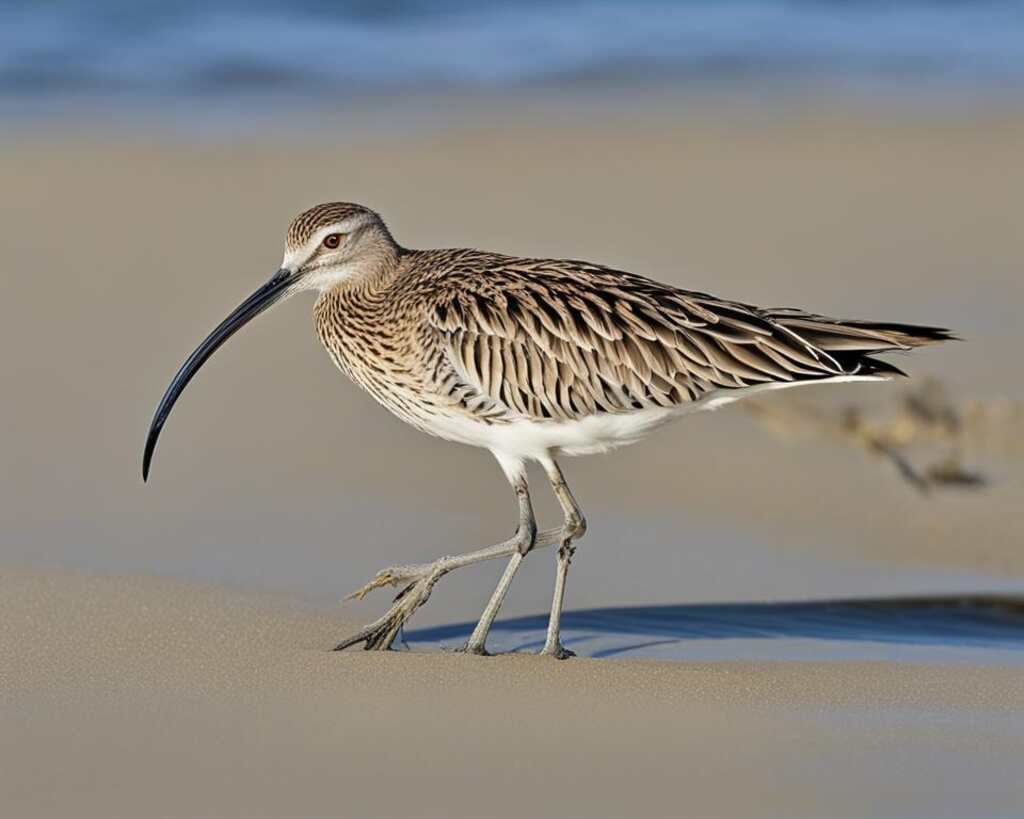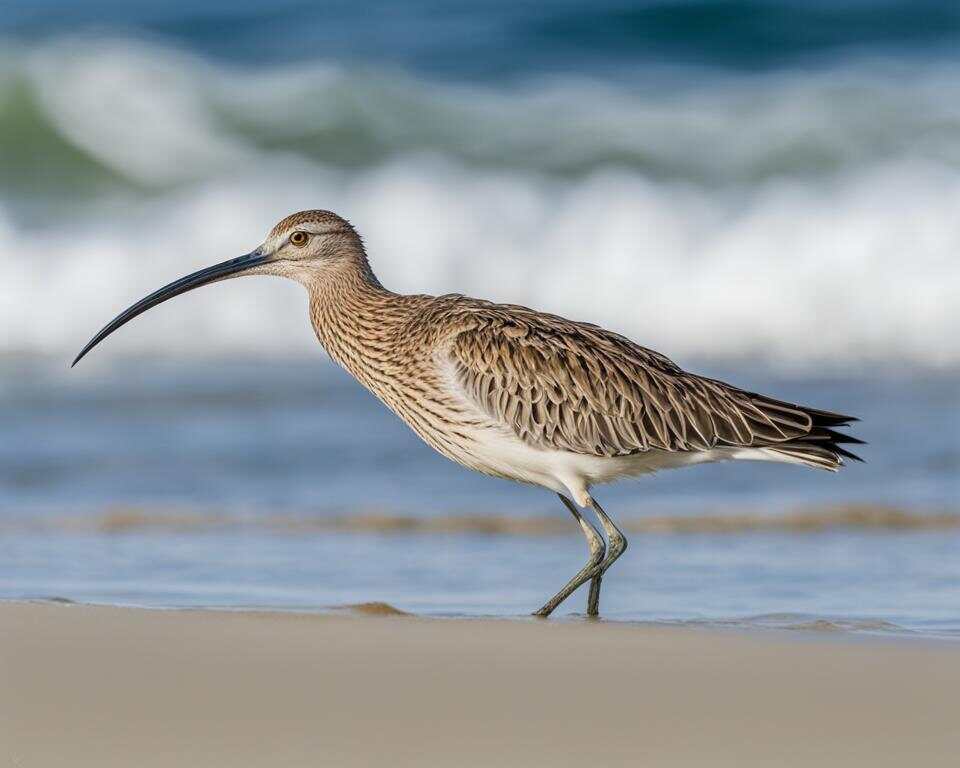I am delighted to introduce you to the fascinating world of shorebirds, where one particular species stands out with its unique curved beak. These shorebirds, known as Curlews, belong to the family Scolopacidae and possess a distinctive adaptation that sets them apart, their beak.
The Curlew’s curved beak is a remarkable example of nature’s ingenuity in creating adaptations for survival. This medium-sized shorebird with its long, downward-curving beak has evolved to suit its foraging needs in coastal habitats.
In this article, we will look into the unique characteristics of Curlews, their identification, behavior, and their important role in the ecosystem. We will also explore the evolution and function of curved beaks in shorebirds, along with their habitat, behavior, and the significance of beak adaptations.
Table of Contents
Key Takeaways:
- The Curlew is a shorebird species known for its distinctive curved beak.
- The curved beak of the Curlew is a highly functional adaptation for foraging in coastal habitats.
- Curlews can be identified by their long, slender bodies, mottled brown plumage, and unique beak shape.
- Understanding the Curlew’s characteristics provides insights into the diversity of avian adaptations.
- Conservation efforts are important to preserve not only the Curlew populations but also their habitats.
Discovering the Curlew: A Shore Bird with a Curved Beak
The Curlew is a remarkable shorebird species known for its unique characteristics. With its long, slender body, mottled brown plumage, and distinctive curved beak, the Curlew is easily identifiable among other shorebirds. The curved beak of the Curlew is a specialized adaptation that enables it to forage in different environments.
The Curlew’s curved beak is specifically designed to probe the ground and extract prey such as worms, crustaceans, and small insects. This beak shape allows the Curlew to reach deep into the sand or mud to access hidden food sources, making it well-suited for its feeding behavior.
The curved beak adaptations of the Curlew highlight the remarkable diversity of avian species with curved beaks and their ability to thrive in specific ecological niches.
The Unique Characteristics of the Curlew
Aside from its curved beak, the Curlew possesses other unique characteristics that set it apart from other shorebirds. Its long and slender body allows for efficient navigation through coastal habitats and aids in its graceful flight.
Curlew Identification and Behavior
The distinctive characteristics of the Curlew make it relatively easy to identify. The combination of its long, slender body, mottled brown plumage, and curved beak sets the Curlew apart from other shorebird species.
Understanding the Curlew’s Role in the Ecosystem
As a shorebird with a curved beak, the Curlew plays a significant role in the coastal ecosystem. Its foraging behavior helps control populations of invertebrates, such as worms and crustaceans, contributing to the balance of these species in the environment.
Additionally, the Curlew’s feeding activities aid in nutrient cycling, making it an important contributor to the overall health of coastal habitats.
The Evolution and Function of a Curved Beak in Shorebirds
The evolution of the curved beak in shorebirds is a fascinating story of adaptation and survival. These birds’ beaks have evolved to match their food sources and foraging behaviors. The curved beak allows them to access prey buried deep in the sand or mud, such as crustaceans and worms.
The development of the curved beak occurred gradually over time, with the most successful beak designs being passed down through generations. The curved beak’s function in shorebirds is vital for feeding, foraging, and overall survival.
Understanding the evolution and function of the curved beak provides valuable insights into the remarkable adaptability of these avian species.
Exploring the Habitat and Behavior of Curved Beak Shorebirds
Curved beak shorebirds are a diverse group of avian species found in coastal areas and wetlands around the world. These birds exhibit fascinating migratory patterns and demonstrate unique nesting habits and feeding strategies.
Their curved beaks allow them to thrive in different environments, making them well-adapted to their coastal habitats.
Migratory Patterns and Nesting Habits
During the breeding season, these birds display specific nesting habits, such as forming territories and engaging in elaborate courtship displays.
The nesting sites are carefully chosen to provide safety and suitable conditions for raising their young.
Feeding Strategies of Curved Beak Shorebirds
The feeding strategies of curved beak shorebirds vary depending on their specific habitat and available food sources. Some species, like the Long-billed Curlew, use their curved beaks to probe the mud or sand in search of prey such as worms, small crustaceans, and insects.
Others, like the Black Skimmer, employ a unique feeding technique called “skimming,” where they fly low over the water surface and use their lower beak to catch small fish or invertebrates.
Adaptations to Diverse Environments
Curved beak shorebirds have evolved adaptations that enable them to thrive in different coastal environments. Their curved beaks are specifically designed to access food sources hidden beneath the sand or mud.
Additionally, their long legs are suited for wading through water or walking on soft surfaces, while their streamlined bodies allow for efficient flight over long distances. These adaptations make curved beak shorebirds highly specialized for their coastal lifestyle.
Shorebird Diversity: Beaks and Habitats
| Shorebird Species | Beak Adaptation | Habitat |
|---|---|---|
| Long-billed Curlew | Long, downward-curved beak for probing into mud or sand | Coastal marshes, mudflats |
| Black Skimmer | Lower beak longer than upper beak for skimming | Coastal lagoons, estuaries |
| Whimbrel | Downward-curved beak for probing in mud or sand | Coastal wetlands, marshes |
| Ibis | Long, slender, down-curved beak for probing in soil or shallow water | Wetlands, marshes, coastal areas |
| Avocets | Long, thin, upward-curved beak for skimming water | Saline lakes, coastal lagoons, mudflats |
| Slender-billed Curlew | Long, curved beak for probing in mud or sand | Coastal areas, mudflats |
| Godwits | Long, straight to slightly curved beak for probing | Mudflats, coastal areas |
| Dowitchers | Long, straight beak for probing in mud or sand | Marshes, wetlands |
| Spoonbills | Long, flat, spoon-shaped beak for filtering food | Wetlands, marshes, coastal areas |
| Sandpipers | Straight or slightly curved beak for probing in mud | Shorelines, mudflats, beaches |
| Whimbrels | Downward-curved beak for probing in mud or sand | Coastal wetlands, marshes |
Conclusion
The significance of beak adaptations in shorebirds, including the Curlew, cannot be underestimated. These unique beak structures enable shorebirds to access a wide range of food sources and thrive in specific habitats, playing a vital role in the overall health of coastal ecosystems.
Conservation efforts for curved beak shorebird species are crucial for preserving their populations and protecting their habitats. By understanding and appreciating the adaptations of shorebirds, we can work towards their conservation and ensure the long-term sustainability of these avian species.
Encouraging continued interest in avian ecology and birdwatching is essential. It raises awareness about the importance of shorebird conservation and contributes to citizen science initiatives.
By connecting with the natural world through birdwatching, we can deepen our understanding of these incredible creatures and inspire others to join in the efforts to protect and conserve their habitats.




